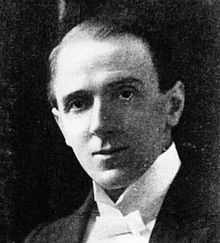Charles Morritt

Charles Morritt (1860-1936, Saxton near Tadcaster) was a magician, hypnotist, mentalist and inventor.
Life and career
Morritt was the son of an elderly gentleman farmer, William, and his young gypsy housekeeper whom he had married at the age of 51. As a teenager Charles worked as a packer in a woollen warehouse in Leeds. He taught himself card tricks and hypnotism in his spare time.
Aged 18, Morritt gave a two hour show at the Public Hall in Selby featuring mind-reading and rabbit tricks as well as a disappearing act using a cabinet he had built himself.[1] On stage, Morritt performed as "The Professor".
He was something of an impresario, having taken over the lease of two theatres and the management of several more in the North of England by 1881.[2]
He later honed his magic under the tutelage of John Nevil Maskelyne.
In 1915, Morritt presented his latest invention, the Tally Ho! trick. An "entire fox hunt": two huntsmen with rifles, a hunting dog, and a lady in green velvet riding on the back of a live horse, were produced from a cabinet.
Morritt knew Houdini well, selling him several tricks, including adapting his own Disappearing Donkey routine into a vanishing elephant trick for Houdini.[2] [3]
Trial
In 1928, a magic trick led to Morritt's appearance in a Halifax court charged with obtaining money by false pretences. The jury were instructed to give a verdict of "not guilty".
After the trial, the then 68 year old magician moved to Morecambe with his assistant Bessie and never worked again.[1][2] He died of tuberculosis in 1936.
References
- ↑ 1.0 1.1 Moore, Victoria (2007-07-31). "The Yorkshire man who taught Houdini to make an elephant disappear". London: Daily Mail. Retrieved 2012-02-04.
- ↑ 2.0 2.1 2.2 . Halifax Courier. 2008-03-20 http://www.halifaxcourier.co.uk/community/nostalgia/curtain_down_on_the_magic_of_charles_morritt_1_1908453. Retrieved 2012-02-04. Missing or empty
|title=(help) - ↑ Steinmeyer, Jim (2003). Hiding the Elephant: How Magicians Invented the Impossible. William Heinemann/Random House. pp. 241–265. ISBN 0-434-01325-0.